TweakTown’s Rating: 98%
The Bottom Line
Exceptional low QD read performance along with unmatched consistency and low power consumption make Micron’s 7500 Series a must have.
Pros
- + QOS
- + Low QD performance
- + Efficiency
Cons
Should you buy it?
AvoidConsiderShortlistBuy
Introduction and Drive Details
Micron’s 7500 Series represents our second look at its class-leading 232-Layer B58R flash for the datacenter. Our first look came via Micron’s ultra-high capacity 6500 ION which is only available at a 30.72TB capacity point 15mm U.3 form factor. From our time spent with the 232-Layer arrayed 6500 ION, we expect the 7500 Series to be fully capable of delivering class-leading performance where it matters most.
Micron’s newest is another wholly vertically integrated SSD just like its predecessor, the Micron 7450 is. All major components are made by Micron, including the flash, DRAM, and ASIC or controller. Even the firmware is in-house Micron. This becomes especially important when it comes to one of the main selling points inherent to the 7500 Series – drop-in readiness.
Drop-in readiness in the enterprise space is rare indeed and a highly prized attribute. Now, because the 7500 Series is essentially a 7450 Series with B58R flash instead of B47R, it is pre-qualified to drop in anywhere a 7450 Series U.3 SSD is currently being implemented. Having the very same 8-channel controller and firmware nearly identical to that of the 7450 means there is no need to spend months qualifying the 7500 series if the 7450 series has already been qualified for the role.
Micron states that its 7450 Series is not EOL and will continue to be produced in parallel with the 7500 series. However, the 7500 Series, unlike its predecessor, the 7450 series, will be produced in one form factor only, that being 15mm U.3. So to quickly recap, Micron’s newest is here to deliver drop-in readiness or fill new mainstream U.3 slots with the class-leading performance of B58R flash, along with known qualifiers.
Okay, now let’s see how the 7500 Series stacks up against some of its contemporary competitors.
Specs/Comparison Products
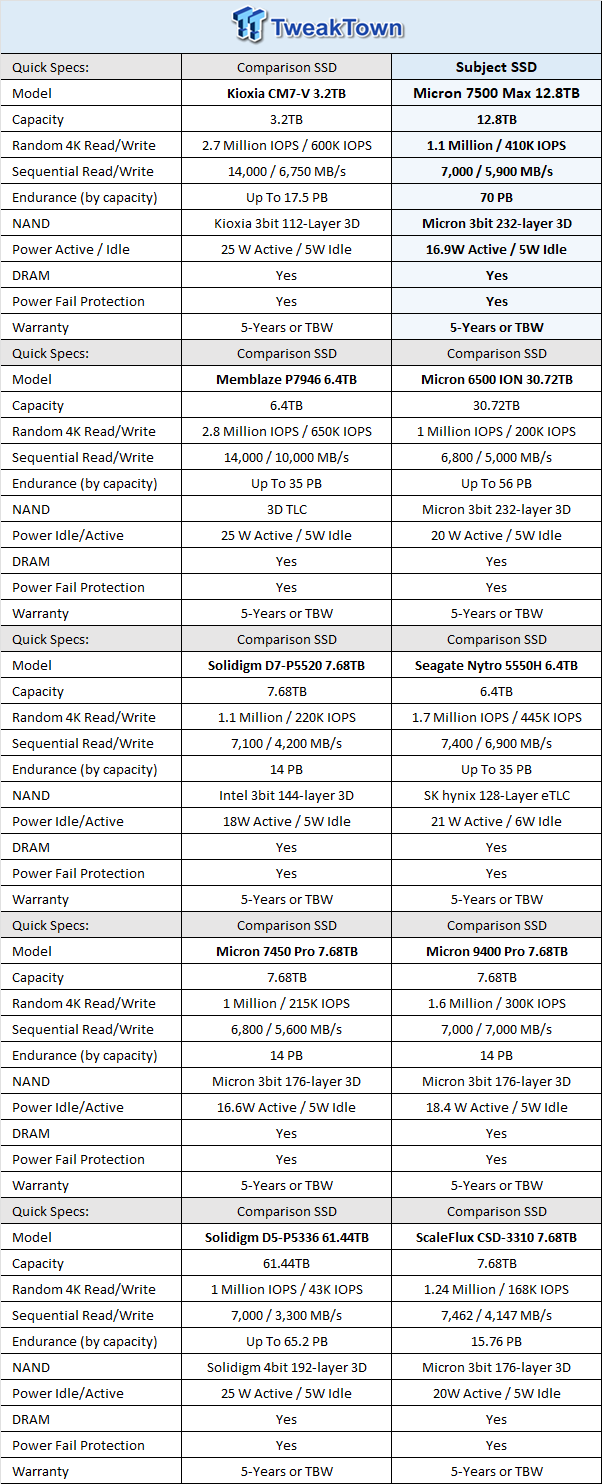
VIEW GALLERY – 33 IMAGES
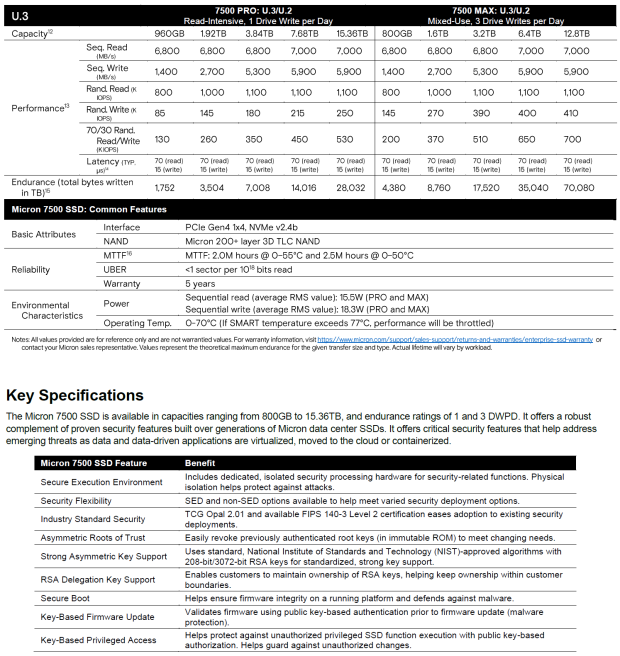
Micron offers its 7500 Series at capacity points ranging from 800GB – 15.36TB in 15mm U.3 form factor. The 7500 Pro is the read-intensive 1-drive write per day option, and the 7500 Max is a mixed-use specialist offering 3-drive writes per day endurance.
Micron 7500 Max 12.8TB NVMe PCIe Gen4 x4 U.3 SSD
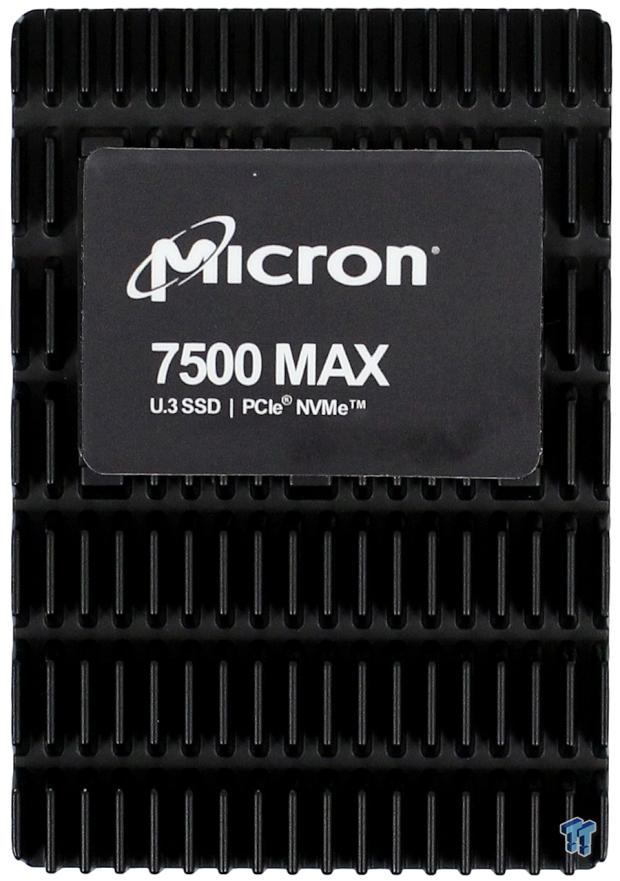
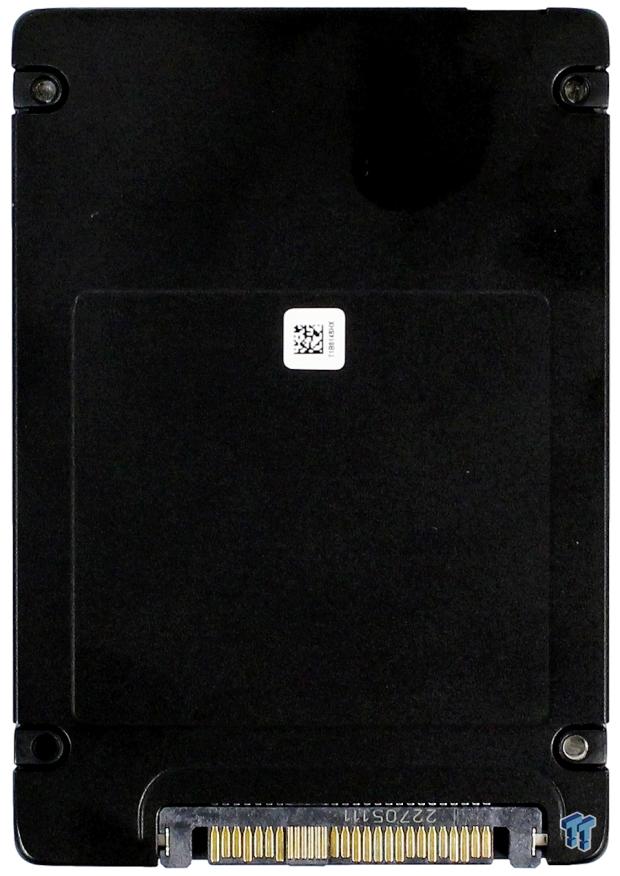
Enterprise Testing Methodology
TweakTown strictly adheres to industry-accepted Enterprise Solid State Storage testing procedures. Each test we perform repeats the same sequence of the following four steps:
- Secure Erase SSD
- Write the entire capacity of SSD a minimum of 2x with 128KB sequential write data, seamlessly transition to the next step
- Precondition SSD at maximum QD measured (QD32 for SATA, QD256 for PCIe) with the test-specific workload for a sufficient amount of time to reach a constant steady-state, seamlessly transition to the next step
- Run test-specific workload for 5 minutes at each measured Queue Depth, and record results

Micron 7450 MAX SSD 12.8TB
| Today | Yesterday | 7 days ago | 30 days ago | ||
|---|---|---|---|---|---|
| $1431.90 | – | – | |||
|
* Prices last scanned on 10/16/2023 at 5:20 pm CDT – prices may not be accurate, click links above for the latest price. We may earn an affiliate commission. |
|||||
Benchmarks – Random and Sequential
4K Random Write/Read
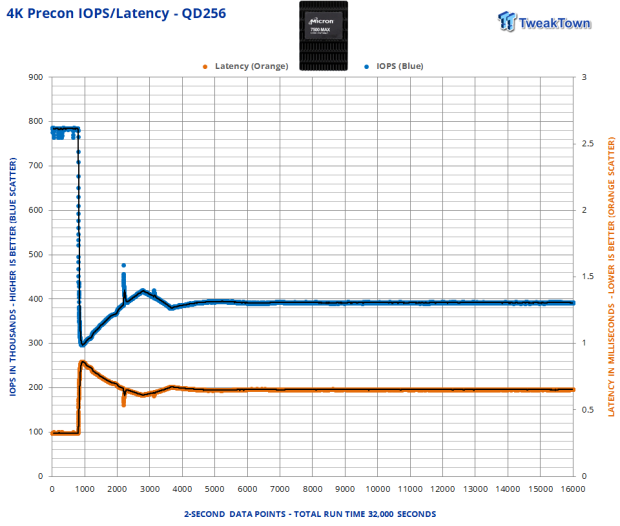
We precondition the drive for 32,000 seconds, receiving performance data every 2 seconds. We plot this data to observe the test subject’s descent into steady-state and to verify steady-state is in effect as we seamlessly transition into testing at queue depth. Steady-state is achieved at 12,000 seconds of preconditioning. The average steady-state write performance at QD256 is approximately 392K IOPS. The incredibly tight pattern is exactly what we want to see from any SSD, with our test subject demonstrating clearly some of the best stability and consistency we’ve ever witnessed from a flash-based offering. Outstanding.
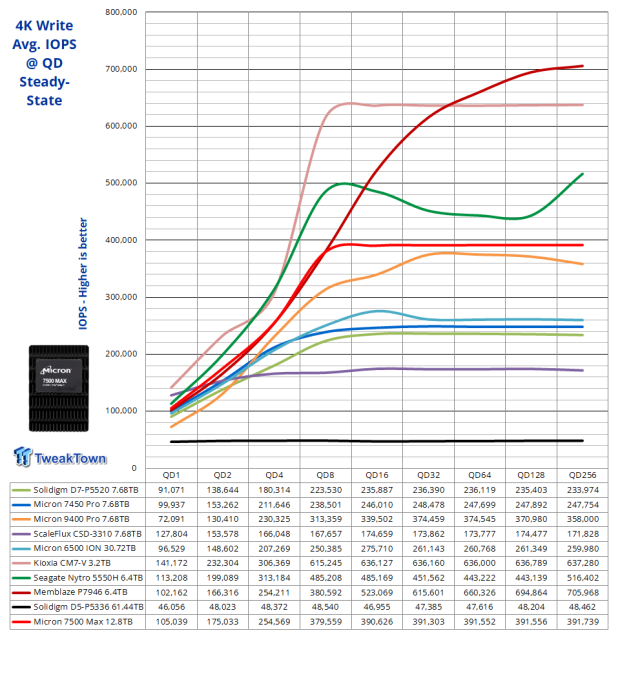
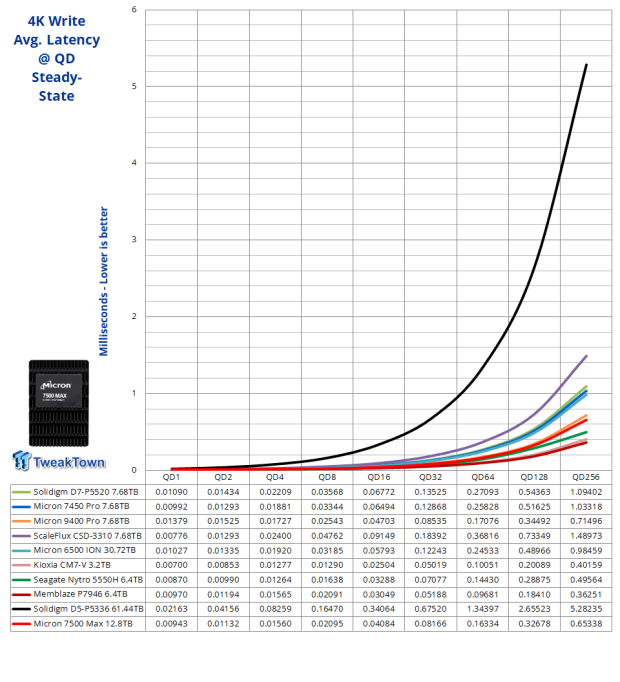
Micron specs its 12.8TB 7500 Max as capable of delivering up to 410K IOPS. We fall short by 18K, which we see no issue with whatsoever. We like the way the drive essentially hits full stride at QD8 and how it delivers exceptionally well at the lowest queue depths, where performance matters most. Do keep in mind that the 7500 series is 8-channel controlled and is far more power efficient than most of the competitors that populate our chart.
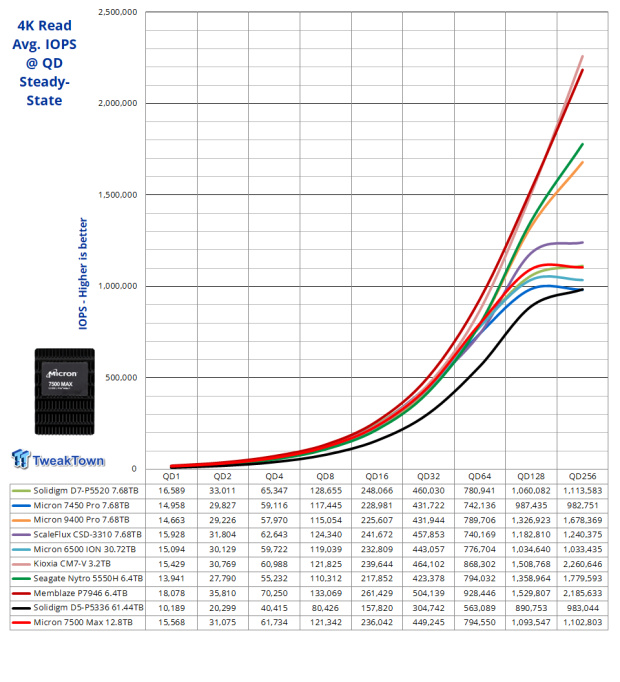
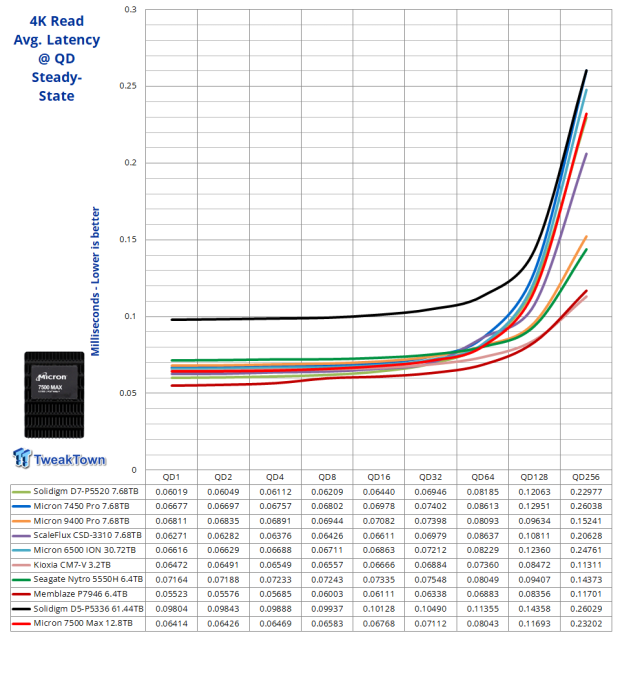
While we cannot compare the pure random write performance of a 3-DWPD SSD to that of a 1-DWPD SSD, we can compare pure read performance because it is the same, as overprovisioning does not affect read performance. With that said, the 7500 Series delivers more random read performance at low queue depths than any Micron SSD we’ve ever tested, including the supremely powerful 16-channel controlled 9400 Pro. Additionally, we are coming up spot on at 1.1 million IOPS as spec’d by Micron. Impressive.
8K Random Write/Read
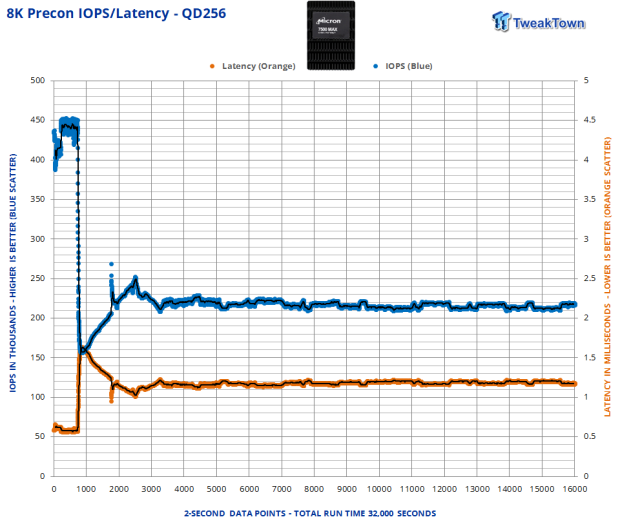
We precondition the drive for 32,000 seconds, receiving performance data every 2 seconds. We plot this data to observe the test subject’s descent into steady-state and to verify steady-state is in effect as we seamlessly transition into testing at queue depth. Steady-state is achieved at 16,000 seconds of preconditioning. The average steady-state write performance at QD256 is approximately 212K IOPS.
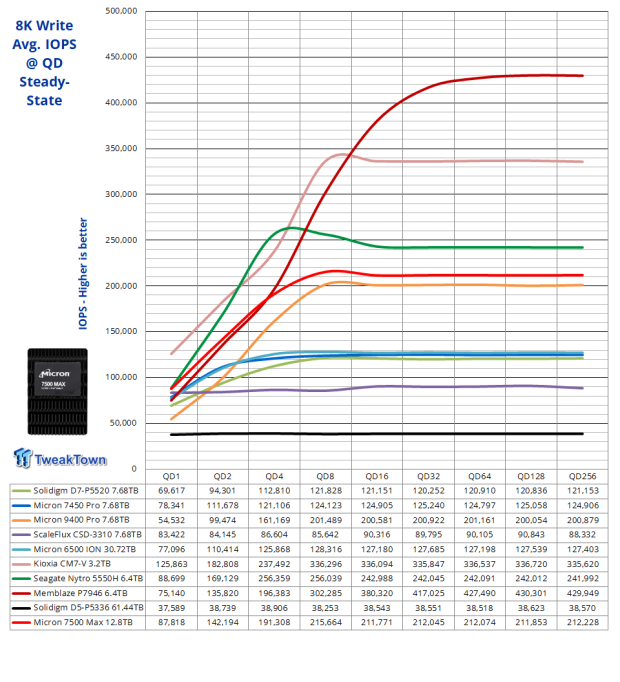
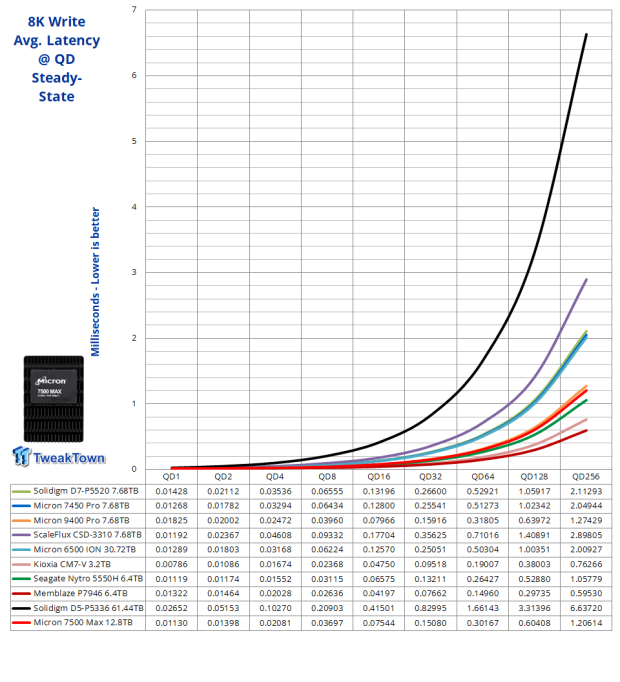
We expect 8K random to track pretty much the same as 4K random here, just at a lower rate because it’s moving twice the amount of data. Again, we note exceptional low queue depth performance where our test subject is delivering the goods at the highest rate we’ve seen from any 8-channel controlled flash-based SSD we’ve tested to date.
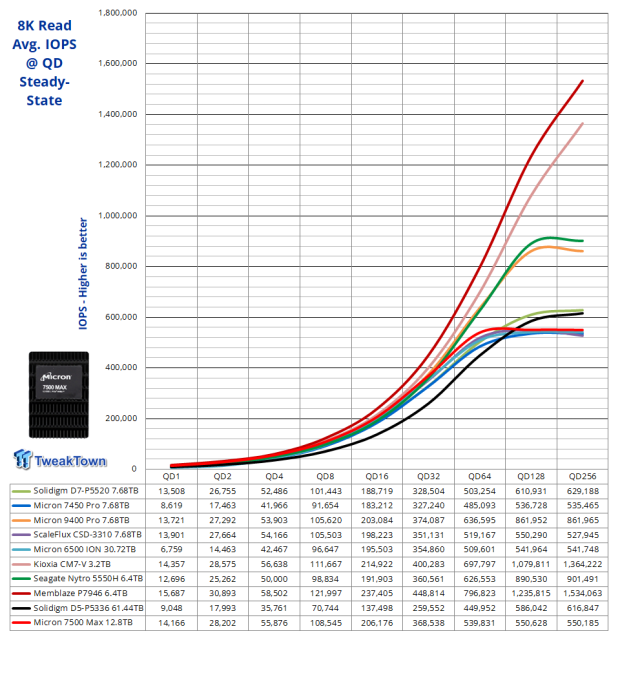
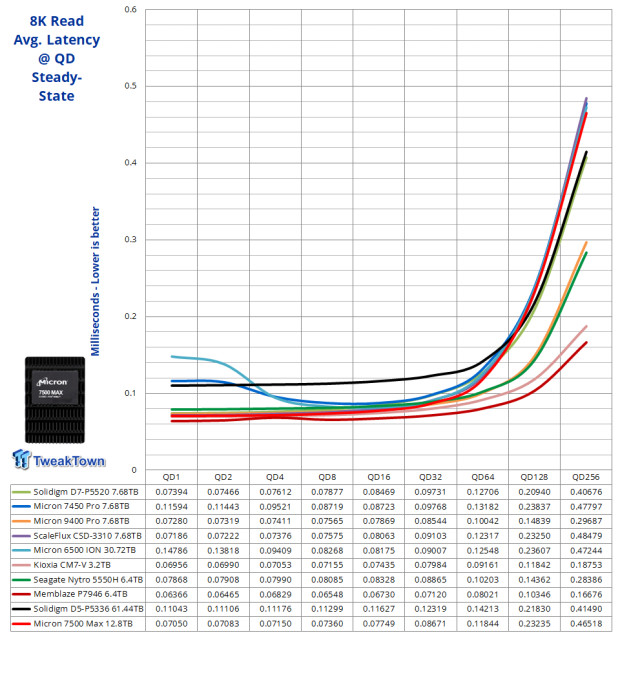
Okay, now this is something to take note of. This is pure read, so this is again an apples-to-apples comparison across the board. QD1 is by far the most important performance metric, and look at the advantage 232-Layer flash has over the 176-Layer that arrays the similarly configured 7450 Pro. Our test subject delivers 64% more performance where it matters most than its predecessor. Only the two PCIe Gen5 SSDs we have charted can deliver more than our test subject. The 7500 Series again sets the performance bar for PCIe Gen4 and does so where it really matters, QD1-QD16 random reads.
128K Sequential Write/Read
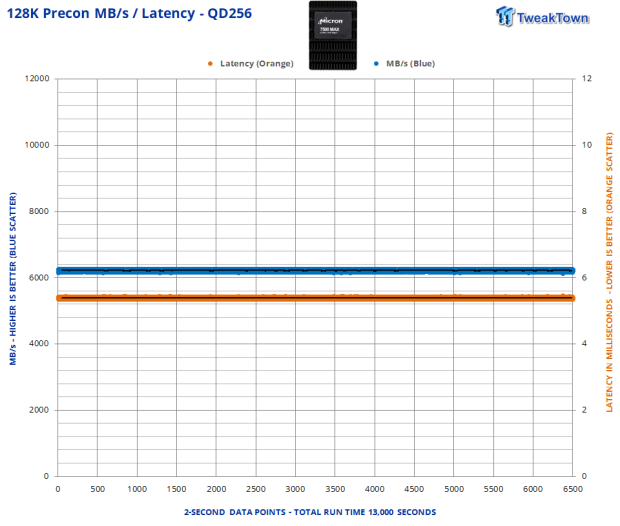
We precondition the drive for 13,000 seconds, receiving performance data every 2 seconds. Steady-state for this test kicks in at 0 seconds. The average steady-state sequential write performance at QD256 is approximately 6,200 MB/s. Again, we note the exceptional consistency so highly prized in the enterprise space as it is possibly the best we’ve ever seen from any flash-based SSD.
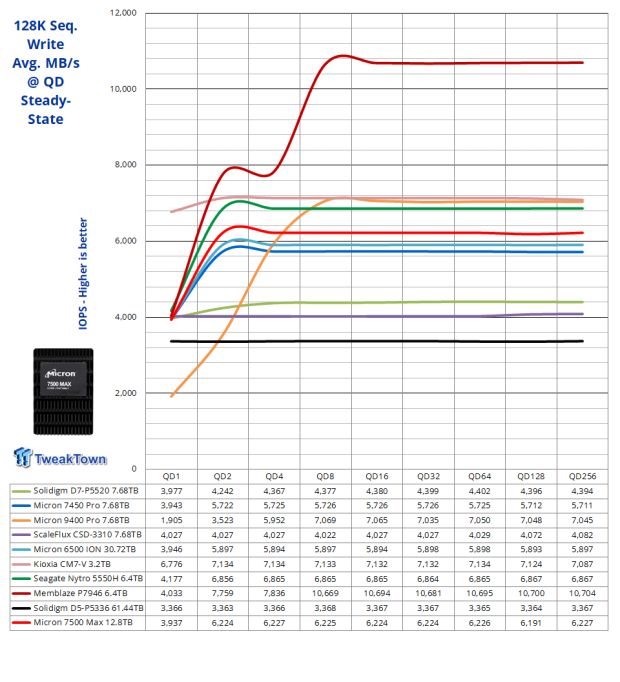
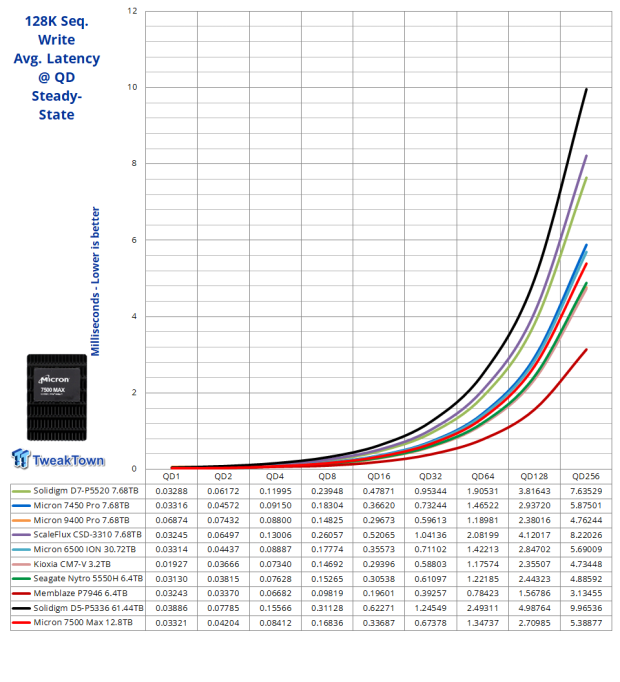
Unlike random writes, sequential writes are unaffected by overprovisioning, so we can compare our test subjects across the board. Capacity can play a role here, but typically not at capacities of 7.68TB and higher; they tend to be directly comparable to one another. The 7500 Series at 7.68TB and higher is spec’d for up to 5,900 MB/s sequential writes; we are getting in excess of 6,200 MB/s. Nice. Of all the Micron SSDs we’ve tested to date, the 7500 Series is delivering the best performance curve of the bunch. As compared against all the contenders that populate our charts, the 7500 series can only be outdone by far more power-hungry 16-channel controlled contemporaries.
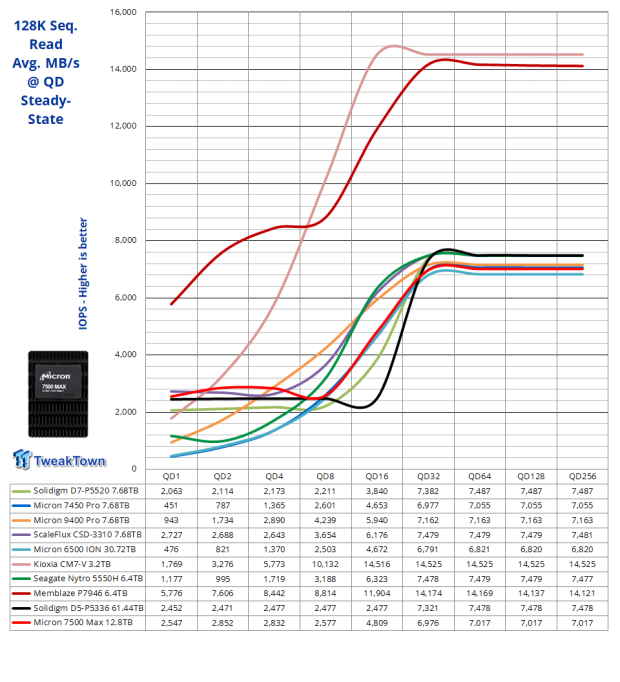
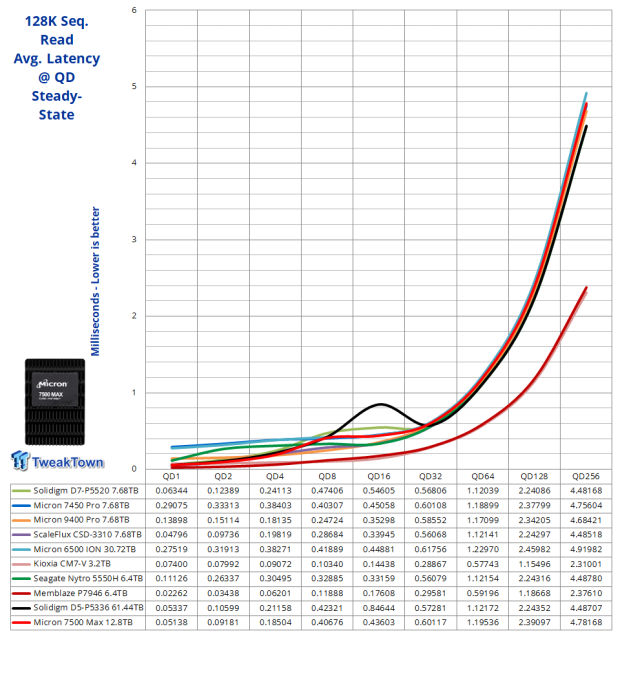
Micron’s spec of up to 7,000 MB/s here is exactly what we are seeing. However, here again, we want to focus on low queue depth performance. The low queue depth advantage the 7500 Series has over any Micron enterprise SSD we have ever tested is quite stunning. Not only is it delivering among the best we’ve seen for any SSD to date, but when we focus on QD1, we find our test subject delivering 2.7x more than Micron’s own 9400 Pro and a mind-blowing 5.6x more than the 7450 Pro. This is performance that matters.
Benchmarks – Workloads
4K 7030
4K 7030 random is a commonly quoted workload performance metric for Enterprise SSDs.
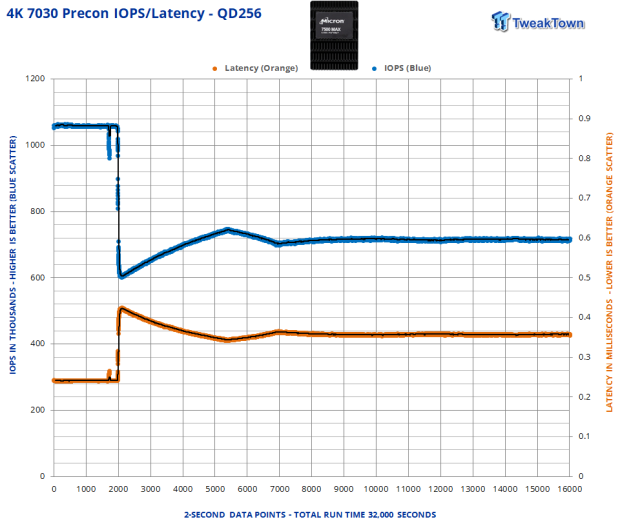
We precondition the drive for 32,000 seconds, receiving performance data every 2 seconds. We plot this data to observe the test subject’s descent into steady-state and to verify steady-state is in effect as we seamlessly transition into testing at queue depth. Steady-state is achieved at 18,000 seconds of preconditioning. The average steady-state performance at QD256 is approximately 715K IOPS. The data pattern generated by our test subject is again among the most, if not the most, stable and consistent we’ve ever witnessed.
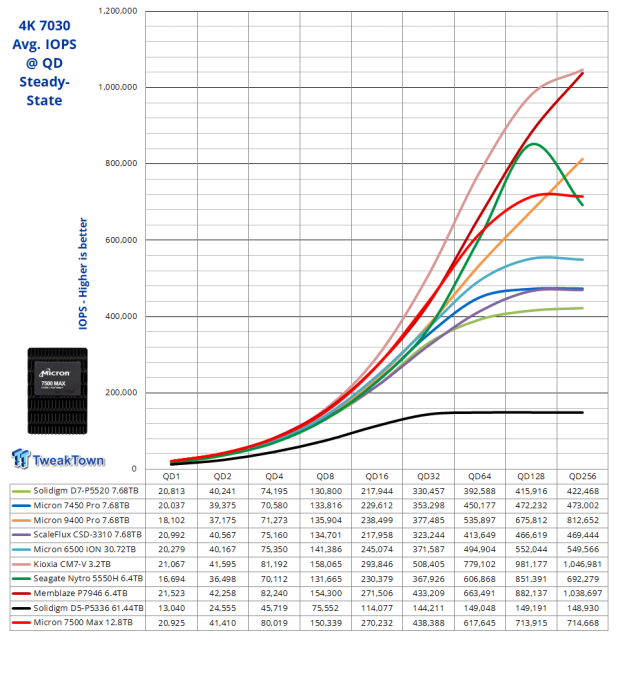
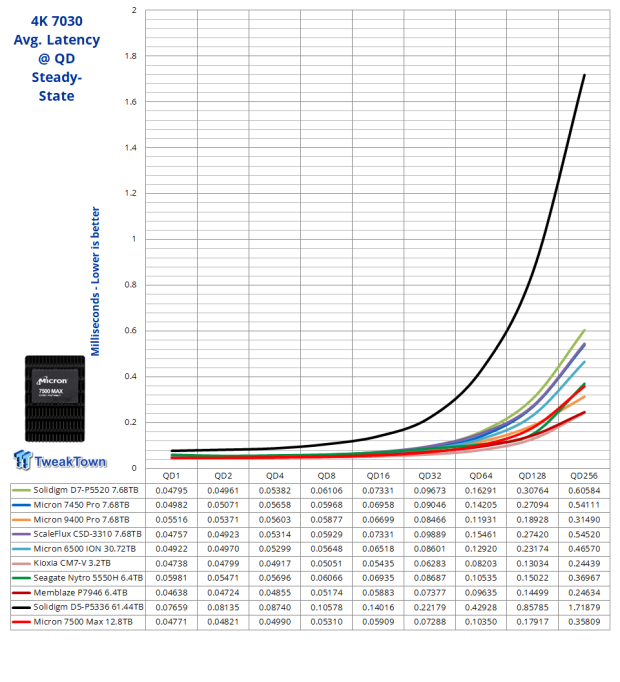
Here, we find our test subject delivering its advertised 700K IOPS and then some. Impressive.
Email Server
Our Email Server workload is a demanding 8K test with a 50 percent R/W distribution. This application gives a good indication of how well a drive will perform in a write-heavy workload environment.
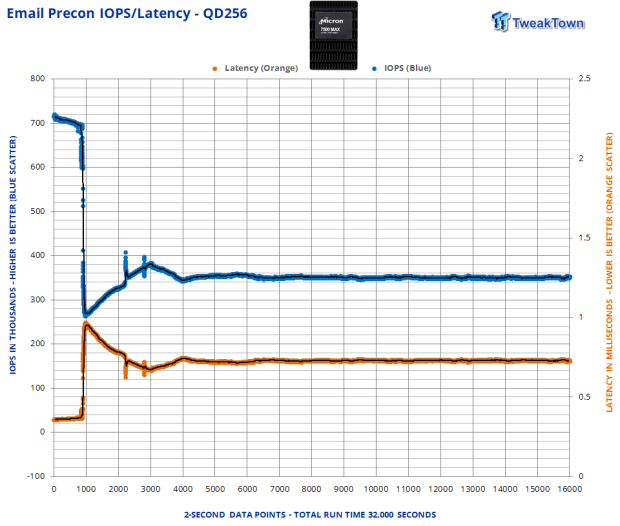
We precondition the drive for 32,000 seconds, receiving performance data every 2 seconds. We plot this data to observe the test subject’s descent into steady-state and to verify steady-state is in effect as we seamlessly transition into testing at queue depth. Steady-state is achieved at 16,000 seconds of preconditioning. The average steady-state performance at QD256 is approximately 350K IOPS. Again, superior consistency and stability are on full display.
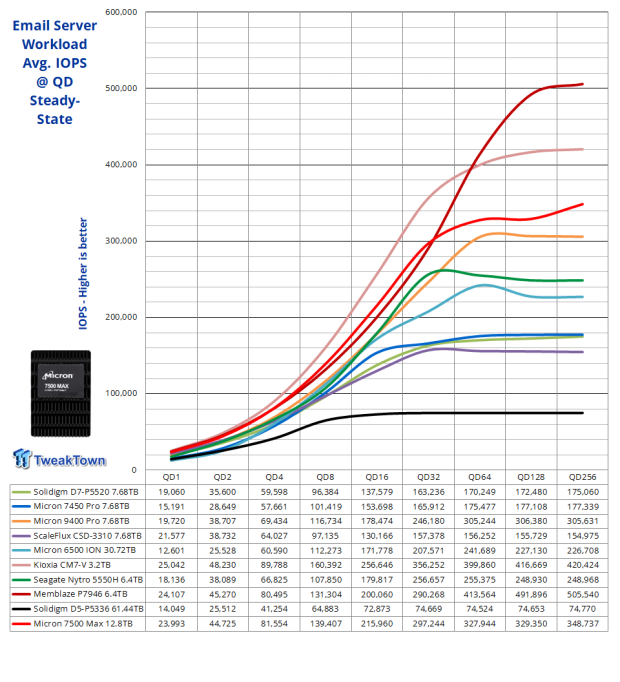
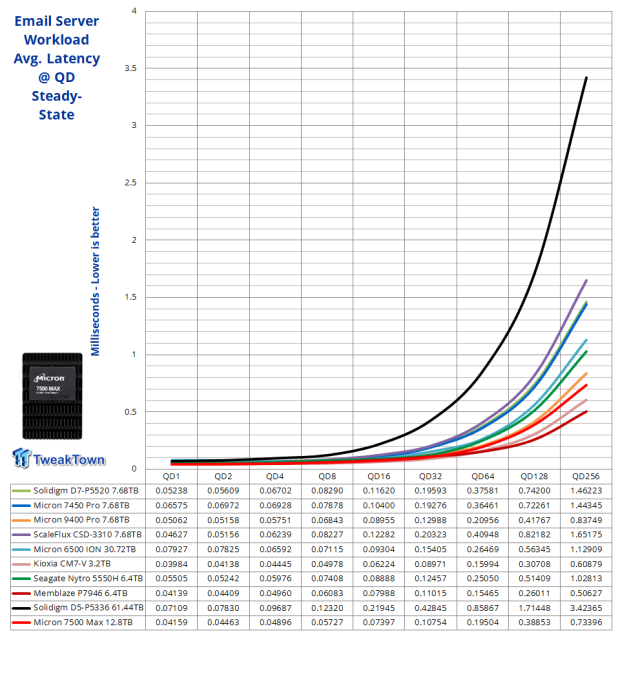
In terms of its performance curve, our test subject is delivering what we would consider the second-best overall we’ve obtained from a flash-based SSD to date. As we see it, only the similarly overprovisioned PCIe Gen5 CM7-V can deliver more performance where it matters most.
OLTP/Database Server
Our On-Line Transaction Processing (OLTP) / Database workload is a demanding 8K test with a 66/33 percent R/W distribution. OLTP is online processing of financial transactions and high-frequency trading.
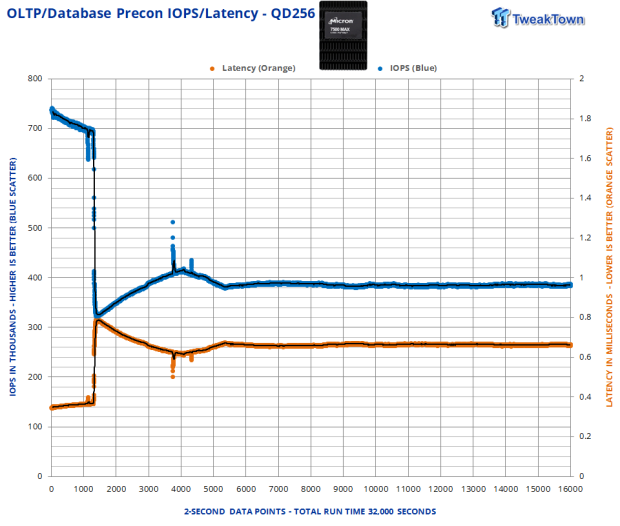
We precondition the drive for 32,000 seconds, receiving performance data every 2 seconds. We plot this data to observe the test subject’s descent into steady-state and to verify steady-state is in effect as we seamlessly transition into testing at queue depth. Steady-state is achieved at 18,000 seconds of preconditioning. The average steady-state performance at QD256 is approximately 384K IOPS.
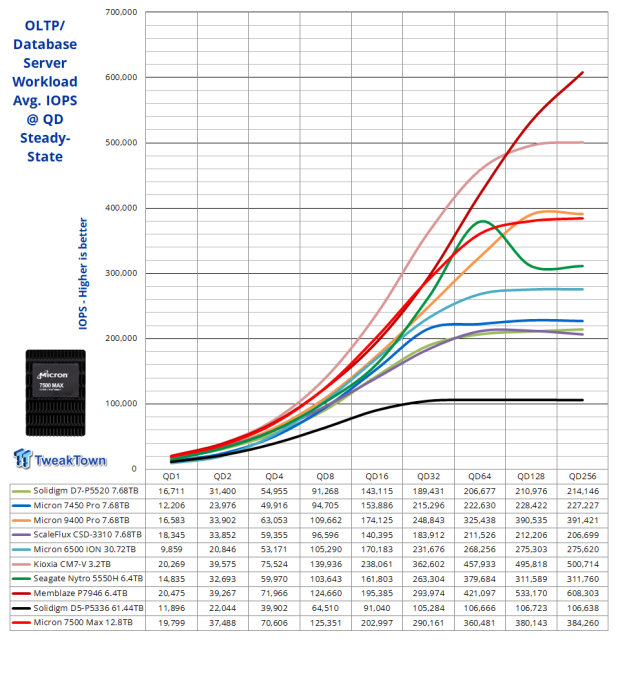
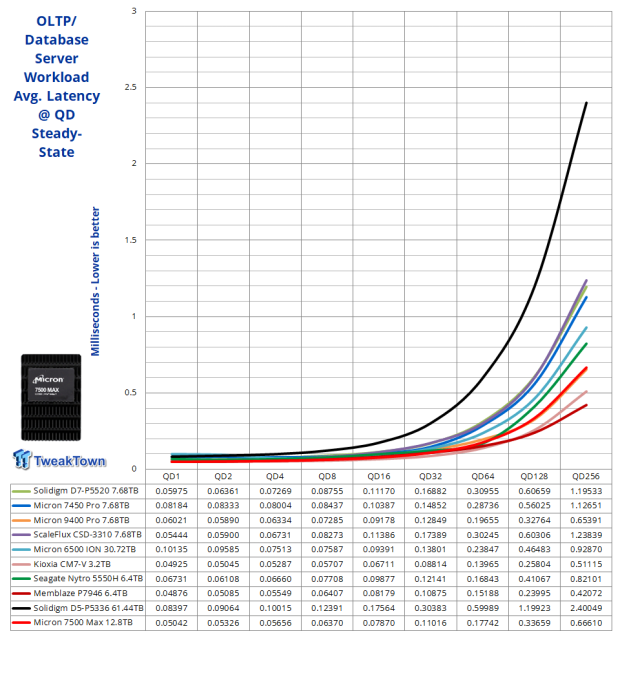
Everything stated about the previous test applies exactly here as well. Additionally, as it applies to direct comparisons, we can do apples-to-apples with the similarly overprovisioned, similarly interfaced Nytro 5550H. Our test subject again, as it demonstrated in the test before this one as well, absolutely crushes its rival, delivering on average 32% more performance where it matters most, and does so with less power consumption, unrivaled QOS, and half the channels. Talk about efficient. Amazing really.
Web Server
Our Web Server workload is a pure random read test with a wide range of file sizes, ranging from 512B to 512KB at varying percentage rates per file size.
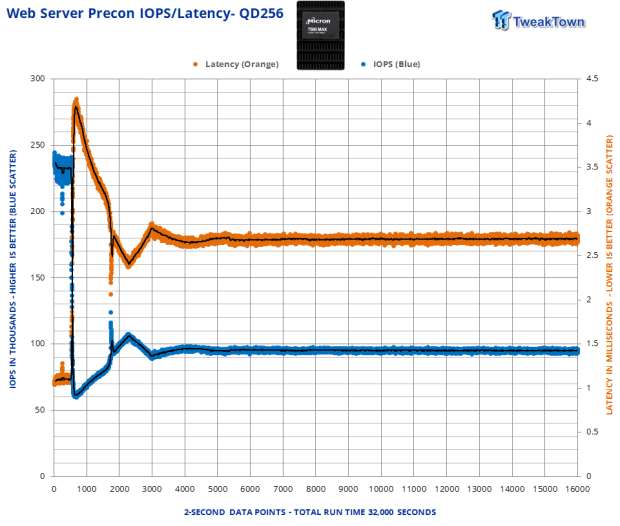
We precondition the drive for 32,000 seconds, receiving performance data every 2 seconds. We plot this data to observe the test subject’s descent into steady-state and to verify steady-state is in effect as we seamlessly transition into testing at queue depth. We precondition for this test with an inverted (all-write) workload, so no relevant information can be gleaned from this preconditioning other than verification of steady-state.
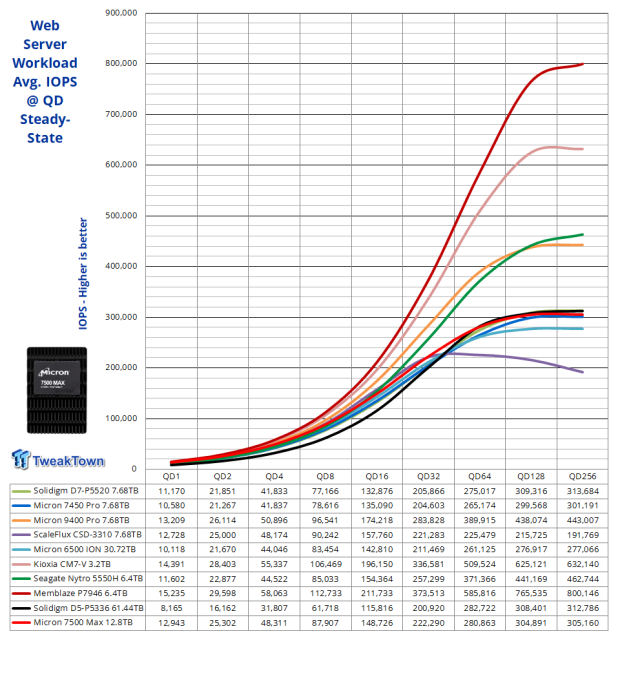
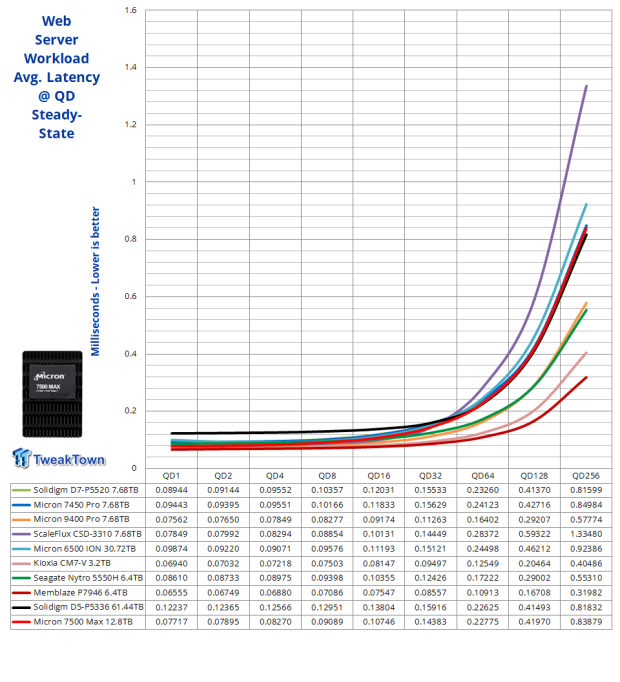
Because this is a pure random read environment with overprovisioning having no beneficial effect on performance, we can do direct comparisons across the board. Comparing our test subject to its predecessor, the 7450 Pro, we find our drop-in ready upgrade delivers 22% more performance at QD1. Impressive. Again, we find that only less power-efficient 16-channel controlled SSDs, two of the 3 of which are PCIe Gen5 interfaced, can outperform the 7500 Series at low queue depths where performance matters most. Of the PCIe Gen4 interfaced contenders, only Micron’s own 16-channel controlled 9400 Pro can deliver better at queue depths of up to 4.
Final Thoughts
As we see it, IOPS per watt efficiency, consistency, and low queue depth random read performance are arguably the most important considerations that factor into selecting the best overall storage medium to populate mainstream slots in the datacenter. Overall, we would have to say Micron’s 7500 Series delivers the best overall balance of these attributes of any SSD we’ve tested to date. Additionally, it’s a known entity for the most part, and in many use-case scenarios, it does not need to go through extensive qualification, making it a drop-in-ready upgrade.
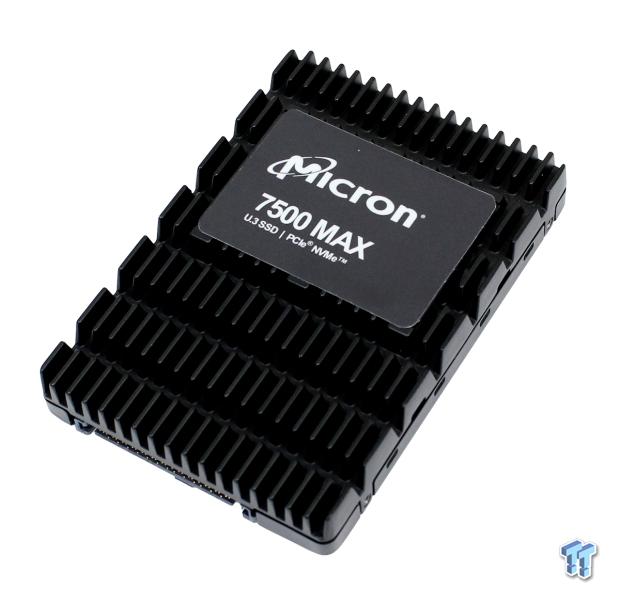
Micron’s 7500 Series has demonstrated to us that it is among the best mainstream enterprise SSDs ever made and, as such, has earned our highest award. Editor’s Choice.
https://www.tweaktown.com/reviews/10558/micron-7500-max-12-8tb-ssd-drop-in-ready/index.html






